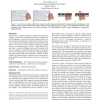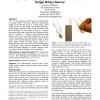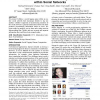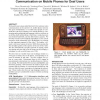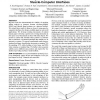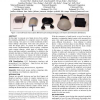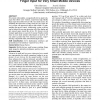UIST
2009
ACM
14 years 6 months ago
2009
ACM
We show how to design touchscreen widgets that respond to a finger’s contact area. In standard touchscreen systems a finger often appears to touch several screen objects, but ...
UIST
2009
ACM
14 years 6 months ago
2009
ACM
We present EverybodyLovesSketch, a gesture-based 3D curve sketching system for rapid ideation and visualization of 3D forms, aimed at a broad audience. We first analyze traditiona...
UIST
2009
ACM
14 years 6 months ago
2009
ACM
UIST
2009
ACM
14 years 6 months ago
2009
ACM
Current interactions on direct-touch interactive surfaces are often modeled based on properties of the input channel that are common in traditional graphical user interfaces (GUI)...
UIST
2009
ACM
14 years 6 months ago
2009
ACM
We present Collabio, a social tagging game within an online social network that encourages friends to tag one another. Collabio’s approach of incentivizing members of the social...
UIST
2009
ACM
14 years 6 months ago
2009
ACM
We describe our system called MobileASL for real-time video communication on the current U.S. mobile phone network. The goal of MobileASL is to enable Deaf people to communicate w...
UIST
2009
ACM
14 years 6 months ago
2009
ACM
Because functional near-infrared spectroscopy (fNIRS) eases many of the restrictions of other brain sensors, it has potential to open up new possibilities for HCI research. From o...
UIST
2009
ACM
14 years 6 months ago
2009
ACM
Previous work has demonstrated the viability of applying offline analysis to interpret forearm electromyography (EMG) and classify finger gestures on a physical surface. We extend...
UIST
2009
ACM
14 years 6 months ago
2009
ACM
In this paper we present novel input devices that combine the standard capabilities of a computer mouse with multitouch sensing. Our goal is to enrich traditional pointerbased des...
UIST
2009
ACM
14 years 6 months ago
2009
ACM
We present Abracadabra, a magnetically driven input technique that offers users wireless, unpowered, high fidelity finger input for mobile devices with very small screens. By exte...
